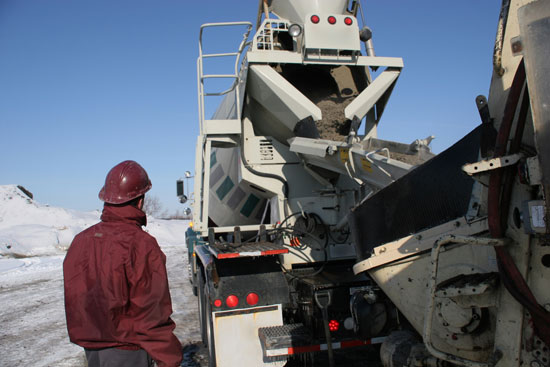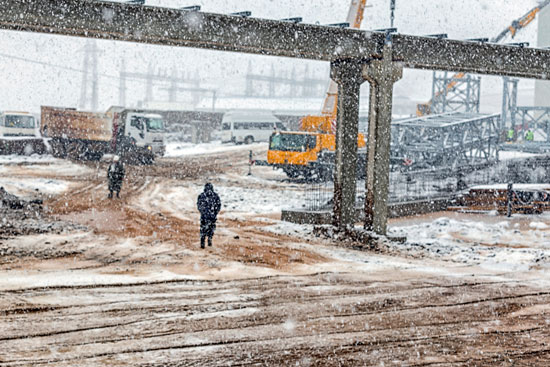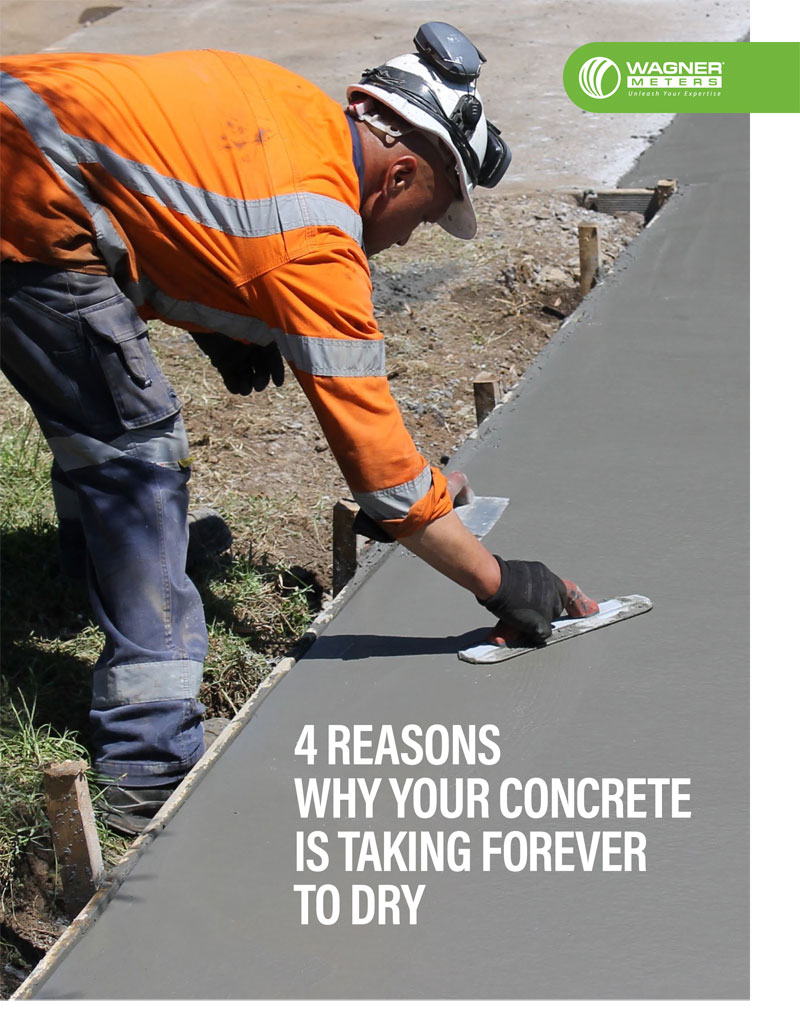Pouring Concrete in Cold Weather – How to Pour
While there does not seem to be a definitive temperature to avoid going below, when pouring concrete…you should clearly define where you draw the line!
When is it too cold to pour concrete?
“The current American Concrete Institute (ACI) definition of cold-weather concreting, as stated in ACI 306 is, ‘a period when for more than three successive days the average daily air temperature drops below 40 degrees Fahrenheit (F) and stays below 50 degrees Fahrenheit for more than one-half of any 24 hour period.’ This definition can potentially lead to problems with freezing of the concrete at an early age.”[1]According to the Portland Cement Association (PCA).
Pouring concrete in cold weather…
Is an ongoing challenge for concrete professionals. Technological advances within the industry provide exceptional advice on how to successfully pour concrete in cold weather. Do these advances provide you with sufficient confidence to make a decision? Are you going to schedule that pour or not?
Is it really wise to concrete when it is cold?
The quick answer to this is to check the weather forecast. If tomorrow’s temperature is going to hover around 32°F, maybe you should consider rescheduling your concrete pour for another day.
But sometimes the answer isn’t as definitive as a specific temperature. The true answer will depend on your approach…and your local resources. But first, let’s step back and look at how temperature affects pouring concrete. What defines cold weather for concrete?
The American Concrete Institute (ACI) – ACI 306R-10 has stated that “cold weather exists when the air temperature has fallen to or is expected to fall, below 40°F (5°C) during the protection period. The protection period is defined as the time required to prevent concrete from being affected by exposure to cold weather.”[2]
Concrete contractors living in climates that deal with temperatures routinely falling within this range realize they have to “think outside the foundation box.” Let’s get to ground zero and see how it is done!
Planning your concrete pour for your specific scenario is key…
What if the ground is frozen?
 If the ground is frozen, expansion occurs creating an unstable support for a foundation. When a load is applied in the form of a structure on the foundation, settling can occur as the ground begins to melt.
If the ground is frozen, expansion occurs creating an unstable support for a foundation. When a load is applied in the form of a structure on the foundation, settling can occur as the ground begins to melt.
James R. Baty II CFA, the managing director of the Concrete Foundations Association, wrote that “the foundation system is designed based on the strength or rather that bearing capacity of the supporting soil. When the ground becomes frozen, its volume expands from the creation of ice particles and therefore changes its support condition. Once the frozen ground has received a structure, that structure is falsely supported by the expanded grade and will experience settlement as the ground thaws.”[3]
With this concern in mind, I am going to share key strategies to help you plan…and successfully complete your concrete project during the cold winter months.
Keep the subgrade from becoming frozen. Thaw the subgrade (any subsurface material that directly impacts the concrete pour area) if it is frozen. Do whatever is necessary to avoid pouring concrete over a frozen subgrade (pyrotechnics are not recommended)! If the subgrade is frozen, the potential for settlement is not the only issue.
Concrete is a porous material and has the potential to absorb moisture from the subgrade…potentially weakening its ability to develop strength. (Remember…if you are pouring a concrete slab, a vapor barrier should be placed between the subgrade and the concrete. Make sure that the vapor barrier you choose complies with the ASTM E1745 standard.)
How to help prevent concrete freezing?
Prevention includes covering the subgrade with insulating materials such as blankets or straw, in order to keep it free from ice and snow. If the subgrade freezes, it may be necessary to excavate to a level below the frost line and remove any frozen areas. After adequately thawing, the subgrade material should be reintroduced and compacted with frost-preventive measures in place.
It may be necessary to cover the foundation forms, steel rebar, and even tools to be used during the pour with insulating blankets so they remain as warm as possible. Any physical element that concrete is exposed to can be a source of heat loss during a concrete pour (even tools)! You should plan for all the contingencies you can think of…
The International Association for the Properties of Water and Steam (IAPWS) states that “when liquid water is cooled, it contracts like one would expect until a temperature of approximately 4 degrees Celsius is reached. After that, it expands slightly until it reaches the freezing point, and then when it freezes it expands by approximately 9%”.[4] That is pretty dramatic evidence of the thermodynamic properties of water…and how it can affect subgrade compaction.
Control the temperature during cold weather concreting.
Good planning includes a conversation with the ready-mix concrete company regarding ways to maintain temperature control while pouring concrete in cold weather.
This conversation should include…

Know what temperature water you are adding.
Water can be too hot for a concrete mix. “Water temperatures ranging between 140 and 180 degrees F can be used, but temperatures above 180 degrees F will compromise the mix. To prevent the possibility of concrete flash setting, at no point should the cement be allowed to contact the hot water; instead, the aggregate should be mixed into the water prior to the addition of cement.”[5]
Consider heat-loss if the mix is not made on site.
“For every 10 degree F difference in concrete temperature, set time will increase by 1/3rd of value (example: a 6 hour set at 70 degrees F equals an 8 hour set with the same concrete at 60 degrees F.)”[6] Knowing the expected transit time from the batch plant to the job site, provides the opportunity to approximate heat loss…and how it can affect set times once the concrete has been poured.
Plan the types of accelerating admixtures that will work best for you.
“Two types of accelerators are calcium chloride and a non-chloride type. Calcium chloride, however, can cause corrosion to any steel used in the concrete. The non-chloride type, however, is not corrosive and can be used in much larger quantities”.[7] “If reinforcing steel won’t be needed, the most effective mix adjustment is the addition of either calcium chloride or an accelerating admixture containing calcium chloride.”[8] “Calcium chloride helps speed up the hydration process of concrete by acting as a catalyst to help free calcium oxide within the cement, allowing faster initiation of the hydration process and quicker achievement of the critical 500 psi (3.5 Mpa) compressive strength”.[9]

Free Download – 4 Reasons Why Your Concrete Is Taking Forever to Dry
Think about what types of additional cement could be added to the mix.
What type of cement produces more effective results, Type I or Type III? Although “Type I cement is proven to be successful in cold weather conditions, Type III can give extra control and protection from the aspect of higher internal temperatures resulting in accelerated strength gain.”[10] “Using Type III (high-early-strength) cement speeds concrete setting time and strength gain. Ground more finely than Type I or Type II cement, type III cement may also contain more tricalcium silicate. Both the fine grind and higher tricalcium silicate content increase the rate at which heat is generated by hydration.”[11]
Will there be frequent shifts in temperature during drying?
Temperature shifts that create a “cumulative effect of successive freeze-thaw cycles and disruption of paste and aggregate can eventually cause expansion and cracking, scaling, and crumbling of the concrete.”[12]
Preventing these types of disastrous results requires adding “air-entrained concrete which contains billions of microscopic air cells per cubic foot. These air pockets relieve internal pressure on the concrete by providing tiny chambers for water to expand into when it freezes. Air-entrained concrete is produced using air-entraining Portland Cement, or by the introduction of air-entraining agents, under careful engineering supervision, as the concrete is mixed on the job. The amount of entrained air is usually between four and seven percent of the volume of the concrete…but may be varied as required by special conditions.”[13]
Simply put…keep the concrete as well as the impact area from freezing!
Remember…“People do not plan to fail, they fail to plan.”[14]
Planning for the cold weather concrete pour is complete. Today is concrete day. Do not neglect having enough plastic, insulating blankets, or straw, etc. to entirely cover the concrete in order to maintain warmth and promote proper curing. In very extreme climates, you may need additional heat sources to maintain the proper ambient temperature.
Once the concrete has been poured and finished, keeping it from freezing is imperative. According to the Portland Cement Company, “all concrete must be protected from freezing until it has reached a minimum strength of 500 pounds per square inch (psi), which typically happens within the first 24 hours.”[15] Furthermore, the “ACI-306R standard recommends that the concrete temperature should be maintained at the recommended placement temperature of 55 degrees F for the required protection period.”[16] James Baty states that “the freezing point of concrete is in the neighborhood of 27 degrees F, depending on the concrete mix.”[17]
“In no case should concrete be allowed to freeze during the first 24 hours after it has been placed. Since cement hydration is an exothermic reaction, the concrete mixture will produce some heat on its own.
Concrete retained in forms or covered with insulation seldom loses enough moisture at 40 to 55 degrees F to impair curing. It is a good practice to leave forms in place as long as possible, because they help distribute heat more evenly and help prevent drying of the concrete.
It is also important to prevent rapid cooling of the concrete upon termination of the heating period. Sudden cooling of the concrete surface while the interior is warm may cause thermal cracking.”[18]
Monitor the surrounding conditions during and after you pour.
A natural result of chemical reactions directly related to concrete setting and curing is heat. It is very important that you have the capability to monitor and record ambient conditions along with the temperature of the concrete as it dries. A simple solution is to purchase an infrared thermometer to measure the concrete temperature and a thermo-hygrometer to monitor the air temperature.
If you’re pouring for a future floor covering and want to monitor the temperature and the relative humidity while the concrete is drying, a data logger is a handy tool. For example, the Wagner Meters’ Smart Logger™ allows you to monitor, capture, and record the ambient conditions for up to 300 days or 12,000 readings.
Pouring concrete in cold weather has always created challenges for concrete professionals…
However, exciting advances within the industry have put the concrete professional in a position to be able to successfully pour concrete in cold weather! Understanding the different options available…knowing which local resources you have access to will give you the confidence to keep your level of production consistent throughout the year!
**Note…always verify with the concrete supplier the amount of any additive to include in the concrete mix.
Previously published by ProInstaller magazine.
References:
[1] http://www.cement.org/learn/concrete-technology/concrete-construction/cold-weather-concreting
[2] https://www.concrete.org/topicsinconcrete/topicdetail/cold%20weather
[3] http://cfawalls.org/concretefacts/2013/11/15/casting-foundation-concrete-in-cold-weather/
[4] http://www.iapws.org/faq1/freeze.html
[5] https://www.forconstructionpros.com/concrete/article/10306898/cold-weather-concrete-pouring
[6] https://www.cemexusa.com/documents/27329108/45560536/cold-weather-concreting.pdf/8a67fa2b-5119-55ba-c212-e3da4b369b39
[7] http://www.stixnstones.com/blog/bid/75732/What-Precautions-Should-You-Take-When-Pouring-Concrete-in-the-Winter
[8] https://www.nrcs.usda.gov/Internet/FSE_DOCUMENTS/nrcs141p2_023585.pdf
[9] https://www.forconstructionpros.com/concrete/article/10306898/cold-weather-concrete-pouring
[10] http://cfawalls.org/concretefacts/2013/11/15/casting-foundation-concrete-in-cold-weather/
[11] https://www.nrcs.usda.gov/Internet/FSE_DOCUMENTS/nrcs141p2_023585.pdf
[12] http://www.cement.org/Learn/concrete-technology/durability/freeze-thaw-resistance
[13] http://www.cement.org/cement-concrete-applications/working-with-concrete/air-entrained-concrete
[14] http://www.azquotes.com/quote/710547
[15] http://www.cement.org/learn/concrete-technology/concrete-construction/cold-weather-concreting
[16] https://www.nrcs.usda.gov/Internet/FSE_DOCUMENTS/nrcs142p2_017796.pdf
[17] http://cfawalls.org/concretefacts/2013/11/15/casting-foundation-concrete-in-cold-weather/
[18] http://www.cement.org/learn/concrete-technology/concrete-construction/cold-weather-concreting
Wagner Meters is a family-owned American business that aims to provide solutions in moisture measurement technology that will enhance the quality and value of each customer’s project. With an almost 60-year legacy of innovation, Wagner continues to be a resource for both individual craftsmen and high-performance commercial endeavors.
Related Posts via Taxonomies
Last updated on June 8th, 2021




Pouring concrete in the cold is a tricky task! This post gave great information on the topic.
This is some really good information about how to lay concrete when it is cold out. I want to get a patio installed soon but its cold out. It is good to know that it can take about 24 hours or 20 days for the concrete to cure when it is cold.